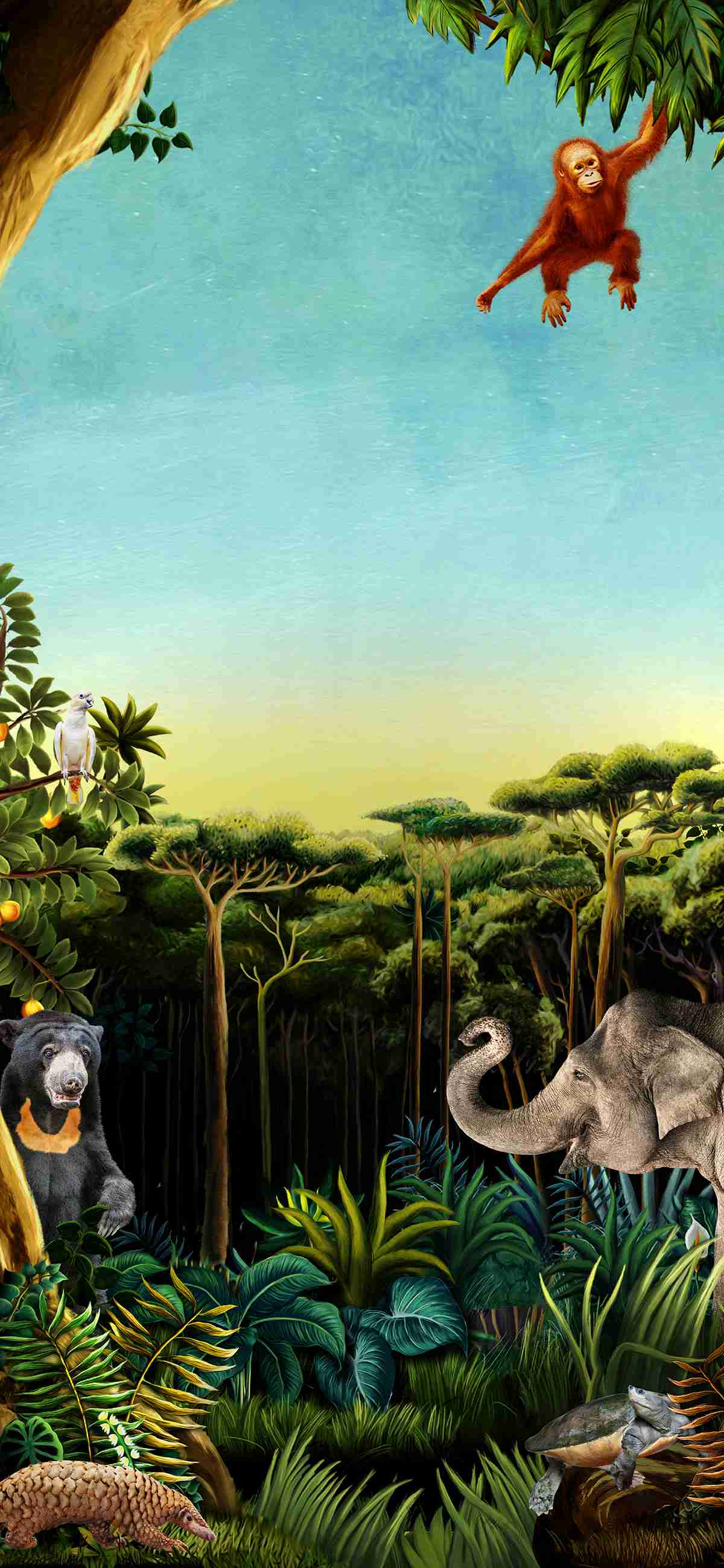Feathered residents take flight in Bird Paradise
04 Apr 2023
Over 40 species of birds now call the Hong Leong Foundation Crimson Wetlands home. The multi-species habitat houses 20 species of parrots including the Hyacinth Macaw, Scarlet Macaw and Blue-throated Macaw, alongside the American Flamingos, Scarlet Ibises and Roseate Spoonbills.
Photo credit: Mandai Wildlife Group
Attention to detail is key as the team meticulously carries out the translocation to make the transition stress-free for both the birds and their caretakers. With hundreds of bird species to move, planning took more than a year to strategise for the wide range of bird species, each with differing needs. The process involved planning the necessary steps, determining the possible risks and actions needed to actively mitigate them, while establishing the best sequence to conduct the move.
Dr Luis Neves, Vice President of Animal Care, Mandai Wildlife Group, said, “More than 2,000 hours later and having covered distances of more than 1,800 kilometres since January, three-quarters of the birds have now been moved safely. The birds are adapting well to the new environment – most are curiously exploring their habitats, some were quick to feast on new varieties of fruit trees in the aviaries, while others got down to weaving nests on tree branches – these are all the beginnings of feeling at home at Bird Paradise. Our priority is to help them settle in and ultimately, we want to see that the birds are enjoying great welfare and adjusting well to their new habitats.”
The Great Migration from Jurong to Mandai

The animal care and veterinary teams work closely on the transfers of the birds from Jurong to Mandai. One of the Shoebills undergoes a physical health check by Dr Gabrina Goh, junior veterinarian, to ensure it is fit for the move while Elden Gabayoyo, Manager, Animal Care, secures the bird.
Photo credit: Mandai Wildlife Group
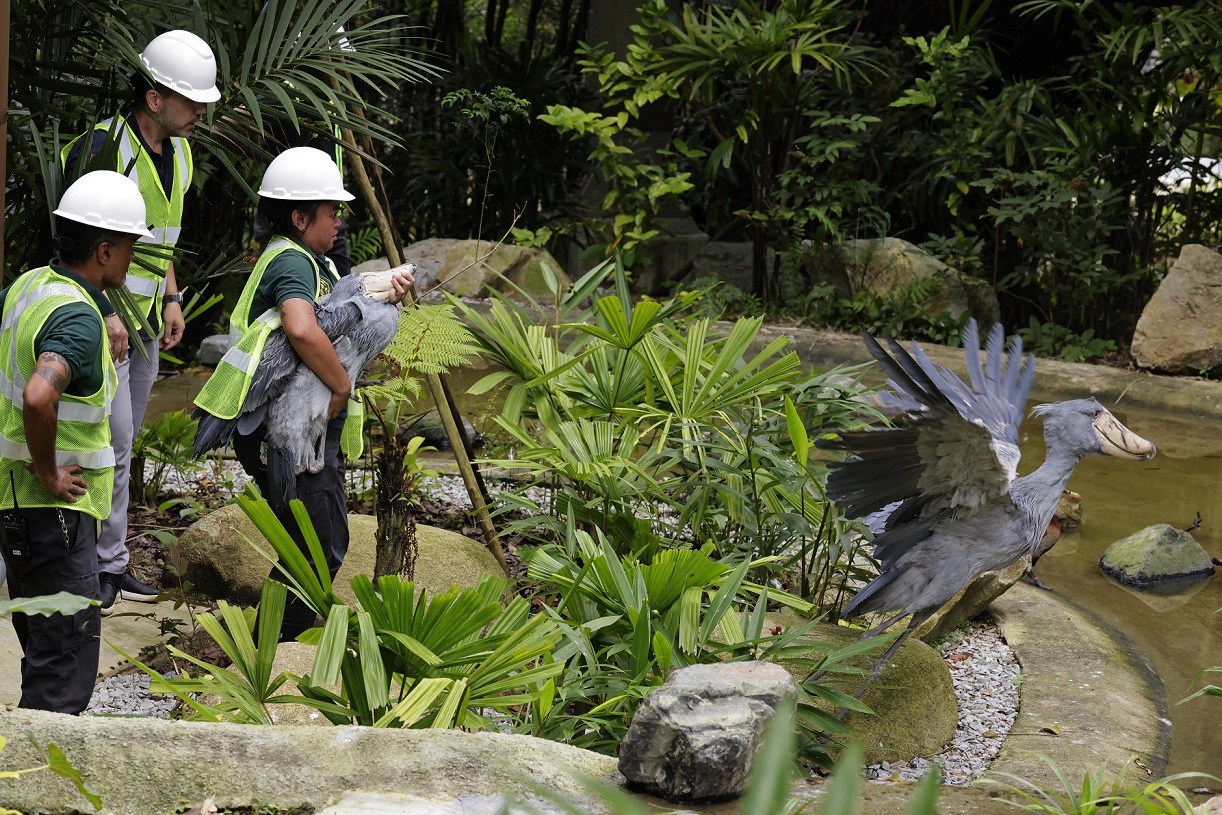
The Shoebills are released to their new habitat in Heart of Africa at Bird Paradise by the Animal Care team. The team will keep a close eye on the birds over the next few days to ensure they are adjusting to the environment.
Photo credit: Mandai Wildlife Group
It has been all hands on deck for the Avian Care, Animal Behaviour and Programmes, Veterinary Healthcare teams who have been core to the massive undertaking in moving over 3,000 birds from Jurong Bird Park to their new home in Mandai Wildlife Reserve.
To safely secure the birds for transfer, one of the critical steps the Avian Care and Animal Behaviour & Programmes teams started working on a year ago was conditioning the birds to the holding areas as well as transport crates that would eventually be used to transfer them. The process involves using positive reinforcement training through a reward – usually food – to encourage the bird to voluntarily enter the crates or pet boxes and get accustomed to being inside. This is done only for a few minutes each time but is repeated at regular intervals. This habitual effort helped the keepers eventually retrieve the birds and transport them in a stress-free manner on moving day.
In December 2022, the teams underwent tabletop exercises and dry runs to simulate every step of the massive move. They role-played the different actions and duties required for the move, from handling the birds, equipment checks and accurate labelling of transport crates to loading up the crate on the vehicles, as well as performing veterinary checks. Driving rehearsals were also conducted to help the drivers familiarise themselves with the travel route and plan for safety measures that may be activated, such as in the event of a vehicle breakdown.
Additional considerations were taken to make the 30-minute journey from Jurong Bird Park to Mandai Wildlife Reserve as comfortable as possible for the birds. Transfers were scheduled early in the morning to take advantage of cooler temperatures. This also allows the birds more time to adjust to their new environment under the watchful eye of their caretakers, making sure they are able to find food and shelter before they roost. Transport boxes were provided for the different sized bird species with padded crates custom made for larger birds like storks and cranes, while perches were mounted in individual pet boxes for the smaller sized birds. The large trucks used to transport the birds were fully airconditioned to keep the temperature cool and the pet boxes were kept covered with cloth to keep them calm during the journey.
Another planning perimeter involved sequencing the move in a tightly coordinated phasing regime to bring about a seamless transfer. Vacating each area of Jurong Bird Park was contingent on the readiness of the aviaries or off-exhibit facilities at the new bird park. Priority was also given to moving birds into the larger aviaries first, as this would enable the operations teams to start shifting concurrently.
Amongst the early birds to move into Bird Paradise were the parrots, hornbills, birds of prey, and other species from the avian presentations and they have since settled in well. At the Sky Amphitheatre, the Animal Behaviour and Programmes team have started to condition the birds to the new amphitheatre stage which includes an LED wall feature to enhance the storytelling elements. The new amphitheatre has also been designed for raptors like the White-bellied Sea Eagle to make longer flights, while other species can take off from higher platforms to showcase flights from heights that were not previously possible at Jurong Bird Park.
Once the birds have settled into the different aviaries, conditioning them in preparation for guest interaction activities such as Keepers’ Talks and feeding programmes will be one of the focus areas for the Animal Care team. At Hong Leong Foundation Crimson Wetlands, the animal care team is working with the macaws while the starlings at Heart of Africa are being trained to respond to audio cues and gather at a designated area for keepers to conduct headcounts.
Immerse in the naturalistic, multi-species habitats
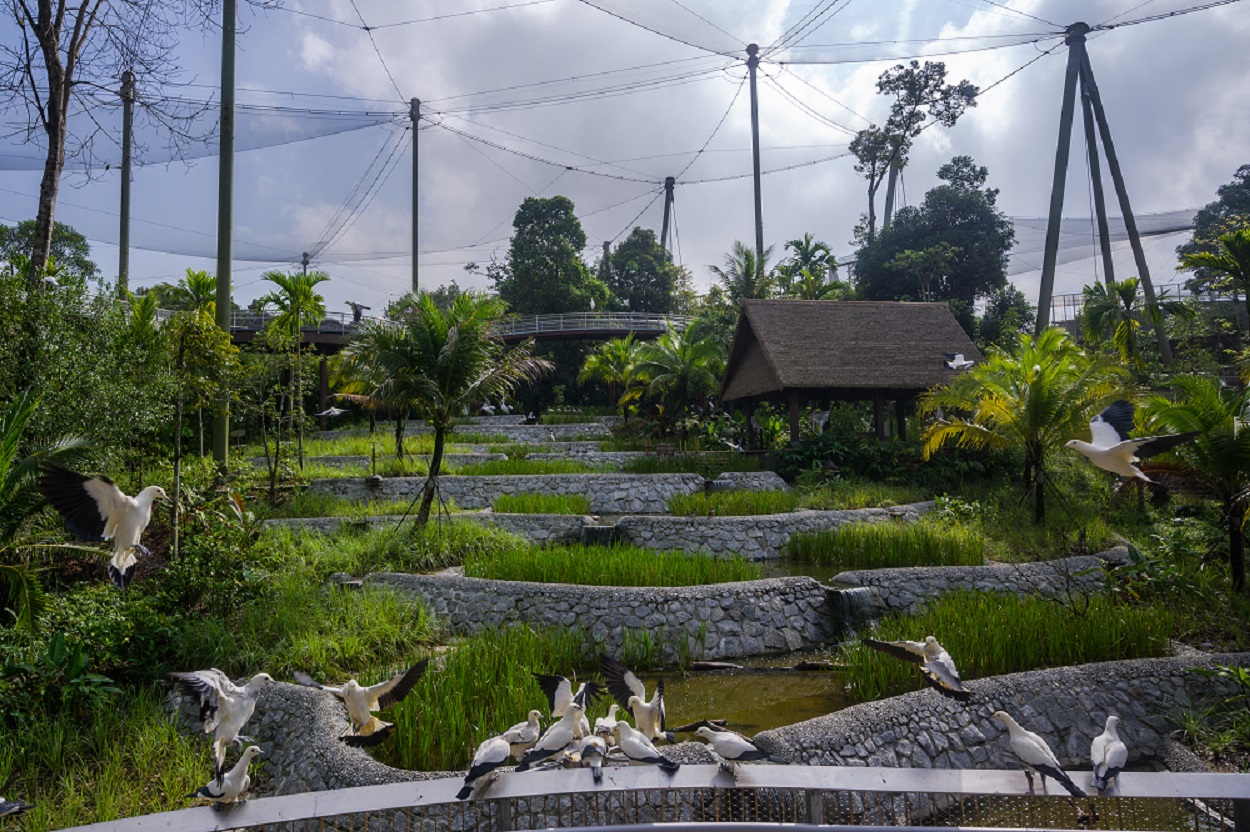
Pied Imperial Pigeons flocking to their breakfast at Kuok Group Wings of Asia. Healthy appetites are good indicators of the birds acclimatising well to their new habitat.
Photo credit: Mandai Wildlife Group
With 3,500 birds from over 400 avian species calling the new Bird Paradise home, visitors will soon be able to get up close with the world’s rarest and most colourful of birds. The population plan not only showcases unique avian species, but also enables the new park to redouble its focus and take a prominent role in avian care, research and conservation efforts while providing opportunities for visitors to connect with these amazing creatures.
A highlight of the new Bird Paradise is the eight walk-through aviaries where visitors can experience the different habitats of the world - from the dense African rainforests and South American wetlands to the Southeast Asian paddy fields, Australian dry eucalypt forests, and more. Multiple species will co-exist in environments designed to resemble their natural habitats and showcase interactions with each other and their surroundings. Decisions were deliberate to ensure the compatibility and needs of each bird species, down to their individual characteristics such as territoriality and habitat requirements, to create an environment where the birds thrive together.
At the largest aviary of Bird Paradise, the 1.55ha Heart of Africa pays homage to various African bird species. 80 species of birds are housed there, including eight different species of Turacos, the largest held in a single area, such as the charismatic Great Blue Turaco, Livingstone’s Turaco, and White-crested Turaco. At Kuok Group Wings of Asia, the Australian Pelicans, along with Black-faced Spoonbills and Milky Storks, can be seen wading through the shallow waters of rice terraces, while the Papuan Hornbills and Pied Imperial Pigeons gracefully soar overhead, creating a captivating and harmonious display of nature.
It is a visual extravaganza of pink and red at Hong Leong Foundation Crimson Wetlands, with species like the Scarlet and Red-and-green Macaws, Scarlet Ibises, Roseate Spoonbills and American Flamingos. Look up above and see flocks of macaws take flight with their loud, raucous calls, producing a symphony of noise. Songs of the Forest and Australian Outback get a boost with additional mammal species such as the Lesser Mousedeer and Red-necked Wallaby, respectively. Home to over 40 species of songbirds, immerse in the beautiful warblings of the Chinese Hwamei, Bali Myna and Straw-headed Bulbul, and spot the extraordinarily coloured fruit doves at the Songs of the Forest or revel in the lively chatter of a multitude of lorikeet and parrot species like the Scaly-breasted Lorikeet, Major Mitchell’s and Red-tailed Black Cockatoo in Australian Outback.
Get up close to unique birds at Mysterious Papua, designed after the landscape of the New Guinean coastal rainforest. Striking species like the Southern Cassowary, Nicobar Pigeon as well as friendly cockatoos such as the endangered White Cockatoo and the world’s largest population of Blue-eyed Cockatoos under human care, take centre stage amidst a backdrop of pandanus trees with their iconic stilt roots. Charming species like the Golden Parakeet, Andean Cock-of-the-Rock, Saffron Toucanet and Chestnut-eared Aracari call Amazonian Jewels home, alongside a diverse family of doves and pigeons such as the Blue Ground-dove and Crested Quail Dove. Visit the habitat of Lory Loft, inspired by the monsoon forest of Irian Jaya and be prepared to be welcomed by the lively chatter of more than 10 species of gregarious lories, each with their own distinct vocalisations.
Journey through the state-of-the-art, multi-level indoor Ocean Network Express Penguin Cove, starting from the deep blue underwater ice formations to the rocky beaches, and observe the penguins waddling under a domed sky with the projection of Aurora Australis around them. Home to four penguin species – the Gentoo Penguin, King Penguin, Humboldt Penguin and Northern Rockhopper Penguin, Ocean Network Express Penguin Cove offers a fascinating look into the oceanic life of these birds.
Visitors to the new Bird Paradise can look forward to spotting several species making their debut. Amongst these are the Goldie’s Lorikeet, a small and colourful parrot species endemic to New Guinea and the stunning European Bee-eater known for its amazing aerial acrobatics as it hunts insects on the wing and striking plumage of green, blue, yellow, and tawny-orange colours, as well as the uncommon and little-known Brown-headed parrot. The Western Piping Hornbill – named after the loud, echoing sound it makes will also be part of the largest living genetic reserve of hornbills in a zoological institution at the new park. Other exciting species that add to the many new species to be discovered at Bird Paradise include the Pompadour Cotinga, a beautiful bird species found in the forests of South America with its unusual bright purple and white plumage, the Epaulette Oriole whose beautiful and melodious songs are often heard during the breeding season and the unusual Grey-winged Trumpeter, a forest relative of cranes.
Conservation at the forefront of Bird Paradise

Threatened cockatoo species like the Blue-eyed Cockatoo (above) and Moluccan Cockatoo (below) being released at Mysterious Papua.
Photo credit: Mandai Wildlife Group
With nearly half of global bird populations declining, zoos have an extremely important role to play in the conservation of species outside of their natural range to prevent extinction. With avian conservation as the cornerstone of Bird Paradise, the park’s conservation efforts will focus on hornbills, Asian songbirds and pigeon species from the Indo-Pacific region. Amongst the rarest birds that will be in the new park include the Philippine Eagles, Negros Bleeding-heart Dove, Baer’s Pochard, Straw-headed Bulbuls as well as Blue-throated, Red-fronted and Great Green Macaws.
Bird Paradise is currently the international coordinator[1] for seven avian species under the EAZA Ex-situ Programme (EEP), including the Knobbed Hornbill, Santa Cruz Ground Dove, Black-winged Myna, Black Hornbill, Moluccan Cockatoo, Straw-headed Bulbul, and Victoria Crowned Pigeon. Managed by the European Association of Zoos and Aquaria (EAZA), EEPs are co-ordinated breeding programmes for threatened species with the aim of maintaining healthy and sustainable populations under human care and developing strategies for the conservation and recovery of these species, linking the work done in zoos to the efforts in the field to protect and conserve the animals and their natural habitats.
Aligned with the park’s commitment to be a globally recognised hub for avian conservation and research, Bird Paradise will participate in over 75 ex-situ managed breeding programmes. New species additions to EEPs include the endangered Madagascar Teal, which is a species of small, brown duck with a pinkish-grey bill and the Knobbed Hornbill, known for its large, curved bill with a prominent knob-like structure on the upper mandible.
The larger and enhanced facilities will see Bird Paradise grow its capacity for species breeding programmes and develop targeted programmes for threatened species like the Negros Bleeding-heart, White-crowned Hornbill, and Vietnamese Pheasant through Mandai Nature, the Group’s conservation arm, to integrate in-park conservation programmes with in-situ efforts for species.
Keeper-led experiences such as Keeper’s Talk and feeding sessions will be available for close encounters with the birds and interactions with the animal care team when Bird Paradise soft opens to the public on 8 May 2023. Proceeds from all animal feedings go into the conservation projects we support in Singapore and across the region.
[1] Each EEP has a species coordinator who is responsible for collecting information on the status of the species in zoos and aquariums, producing and maintaining a studbook, carrying out demographic and genetic analyses, and making recommendations on the breeding status of the animal as well as determine which animal should go where for breeding programmes, after carefully considering their genetic lineage and compatibility.
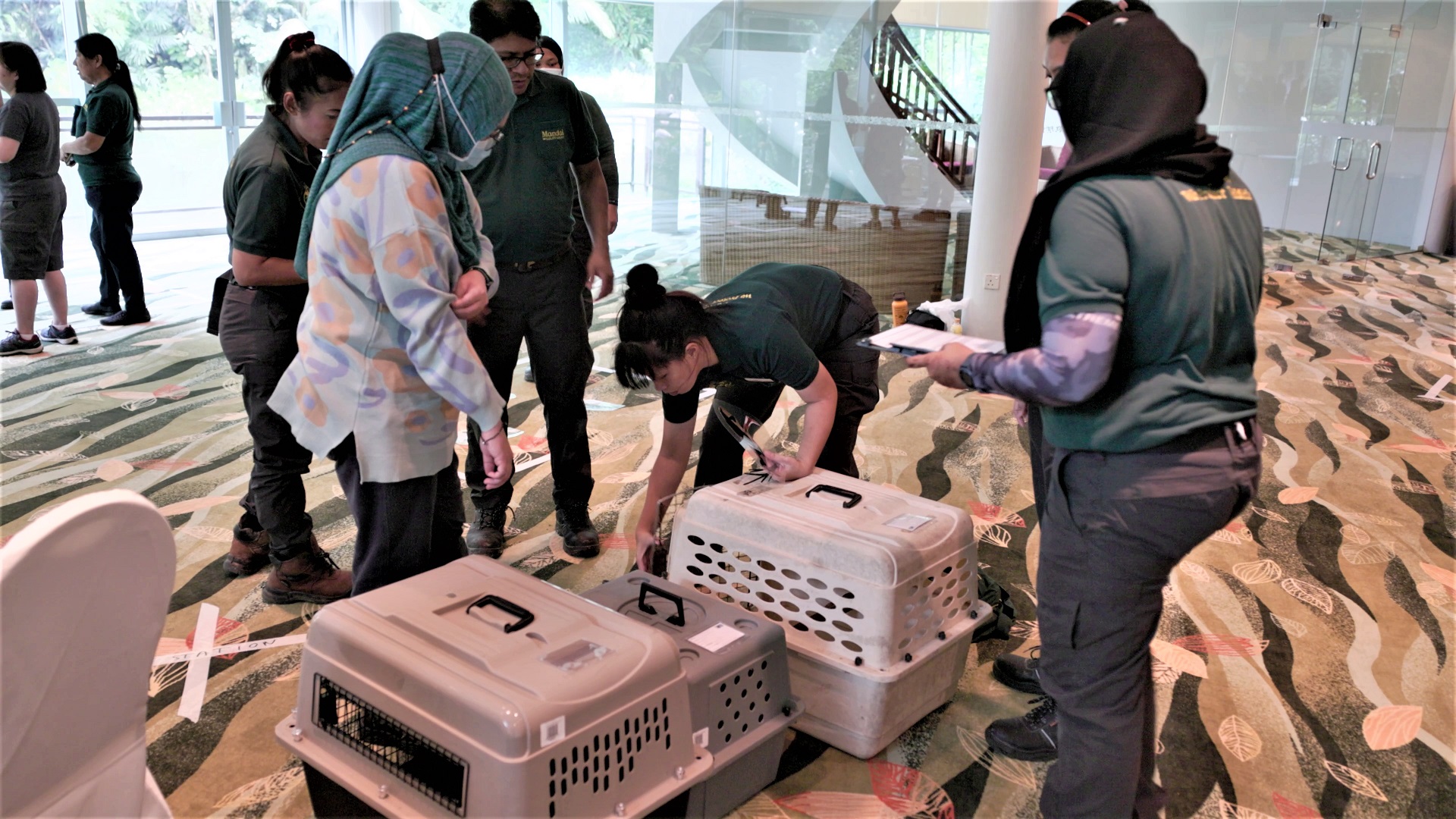
The different teams involved came together for a dry run in December 2022 to simulate the move of birds from Jurong to Mandai and familiarise themselves with the steps needed for a smooth sailing transfer of the birds.
Photo credit: Mandai Wildlife Group
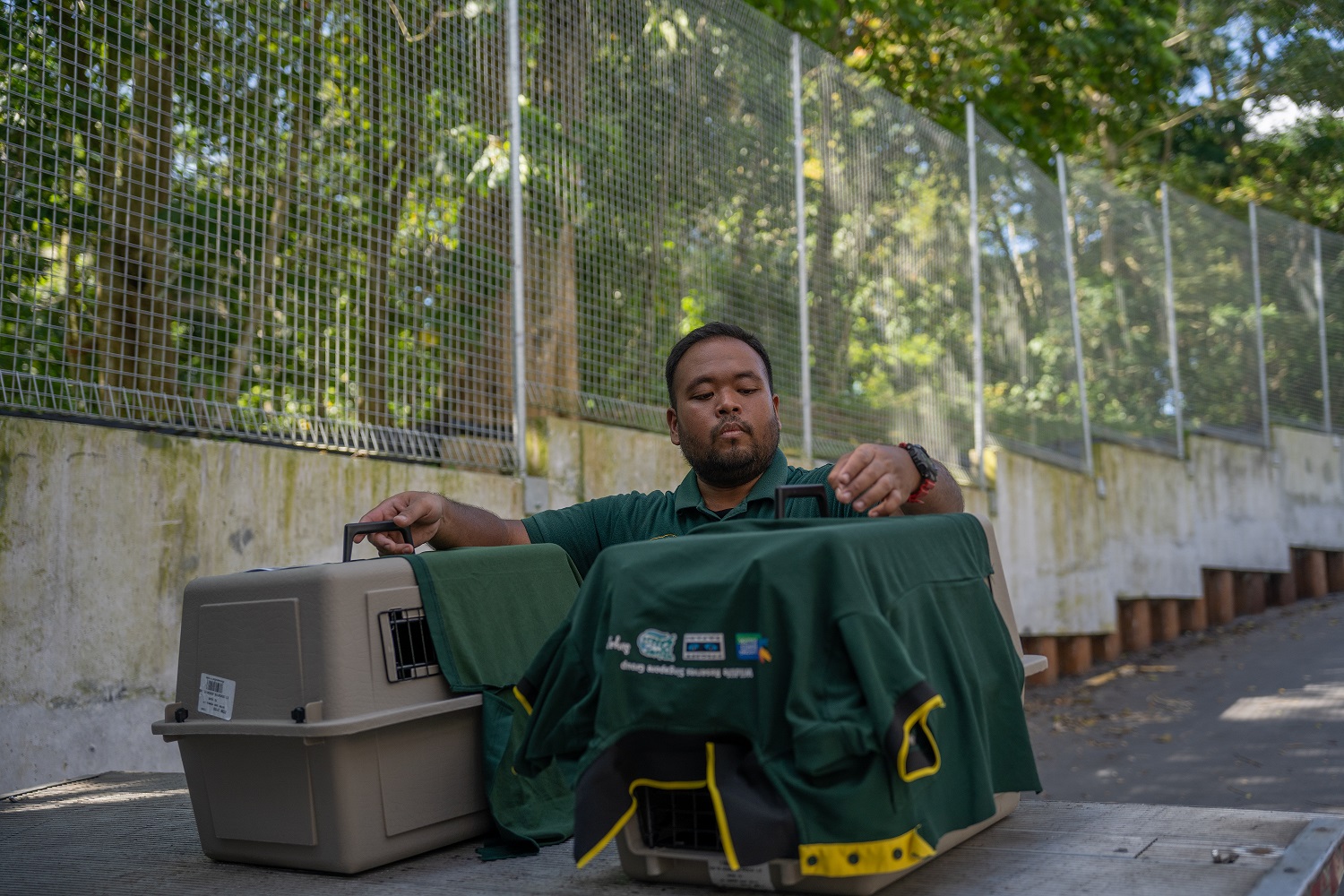
Zaid Harithsah, a keeper from the Animal Care team, loads up the pet boxes to the truck for the birds’ onward journey to Bird Paradise.
Photo credit: Mandai Wildlife Group

A Madagascar Teal (foreground) with three White Faced Whistling Ducks (background) in Heart of Africa. Three Madagascar Teals arrived in Singapore in October last year. This is amongst the several new species that would be brought into Bird Paradise to increase the park’s participation in EEPs.
Photo credit: Mandai Wildlife Group

Scarlet Macaws being released into Hong Leong Foundation Crimson Wetlands, under the careful monitoring of the animal care and veterinary teams.
Photo credit: Mandai Wildlife Group

Each bird is assessed by the veterinary team to determine if it’s fit for move before the transfer. This includes looking out for the bird’s feather conditions and body condition, as well as weight taking. Here, a Hyacinth Macaw is being checked by Dr Ellen Rasidi, veterinarian, before Peter Teo, Deputy Head Keeper, Animal Care, puts it into the pet box for transfer to Bird Paradise.
Photo credit: Mandai Wildlife Group

A female Santa Cruz Ground-dove gets released from one of the pet crates to Mysterious Papua. Bird Paradise holds the only insurance colony of Santa Cruz Ground-doves outside of its native country.
Photo credit: Mandai Wildlife Group

Scarlet ibises released from the pet boxes into Hong Leong Foundation Crimson Wetlands.
Photo credit: Mandai Wildlife Group

Chandramohan, Manager, Animal Behaviour & Programmes, working with a White-backed Vulture as part of preparations for the new Predator on Wings presentation at the brand new Sky Amphitheatre.
Photo credit: Mandai Wildlife Group

Siti Nurhaloyah Tazelah, Junior Keeper, Animal Care, conditioning the Scarlet Macaws at Hong Leong Foundation Crimson Wetlands. The macaws are conditioned to gather at the sound of an electric whistle for future interactive keeper talks and close monitoring by the Animal Care Team.
Photo credit: Mandai Wildlife Group

Look out for the critically endangered White Cockatoo amongst the pandanus trees in Mysterious Papua.
Photo credit: Mandai Wildlife Group

